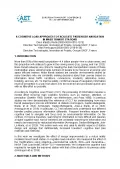-
Past ETC Papers

Browse, search and view papers from the past AET Conferences.
-
Members' Area

AET promotes networking and exchange of ideas, information and opportunities amongst members.
Conference Papers 2024
Antwerp, Belgium
ETC Conference Papers 2024
A cognitive load approach to facilitate passenger navigation in mass transit stations
Seminar
Day 2 (19 Sep 2024), Session 6, How can rail change society?, 13:30 - 15:00
Status
Accepted, documents submitted
Submitted by / Abstract owner
Deyo Maeztu Redin
Authors
Dr. Deyo Maeztu Redin, SNCF (presenter)
Dr. Allan Armougum, SNCF
Short abstract
In this study, we demonstrate the positive impact of applying cognitive load theory to the design of mass transit stations, resulting in significantly improved navigation and user experience.
Abstract
Mass transit stations are complex environments shared by a diverse range of travellers who are constantly making decisions about their journey based on traffic conditions, connections, incidents, alternative routes, or ticketing information. To improve safety, comfort, and ease of navigation, information needs to be presented in a clear and concise manner that can be processed swiftly and effortlessly. Cognitive Load Theory explains the amount of cognitive resources required to complete a task in relation to the available resources and has been proven valuable in modelling how train passengers process information. In this study we explore the application of Cognitive Load Theory to improve the navigation of mass transit stations, specifically investigating the impact of instructional signage design on cognitive load.
The Saint-Michel Notre Dame station is a prototypical mass transit station in the Paris transport network. It serves 32 million passengers annually, including daily commuters, occasional travellers, and tourists. At the time of this study, the station was about to undergo upgrade construction work. Recognising the need for improved navigation, a number of design modifications were identified. These included lighter wall textures, adapted lighting, new information boards, removal of non-essential information boards, specific boards for tourists indicating nearby attractions, and harmonisation of exit numbering. These modifications were tested in a virtual reality twin of the station, that had previously been validated for measuring cognitive load.
Sixteen volunteers with different expertise profiles performed a task that required them to visit all areas of the station. Cognitive load was assessed using declarative (NASA Task Load Index) and physiological indicators (electrodermal activity). Results were compared with a similar experience conducted in an unmodified station. The study found that completing the task in the modified station resulted in significantly lower cognitive load compared to the original station, evidenced by lower scores in mental demand (26 vs 79 in NASA TLX score, p<0.05), performance (23 vs 78, p<0.05), and frustration level (24 vs 67, p<0.05). Furthermore, the improvement in navigation was quantified by a decrease in mean phasic electrodermal activity (mean SCR 2.28 μS vs 3.24 μS), a biomarker of stress-related effects.
This study demonstrates the usefulness of Cognitive Load Theory as a guiding framework for improving the design of mass transit facilities. The creation of a virtual reality model is a simple method of assessing the impact of design changes on cognitive load before actual implementation, providing valuable insights for future mass transit infrastructure.
Programme committee
Intelligent Mobility - Management and Operation
Topic
Human wellbeing
Documents:

Association For
European Transport
Forester House
Doctors Lane
Henley-in-Arden
Warwickshire, UK
B95 5AW
+44 (0) 15 64 793552
VAT number: 710 1866 64
Conference Supporters & Endorsers




Legal Entity
The Association for European Transport is registered as an Association ('vereniging') with the Chamber of Commerce for Haaglanden in The Netherlands under company number 27170096.
Built on Zenario




